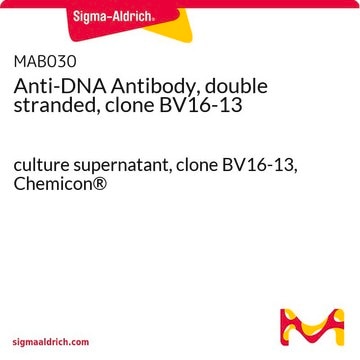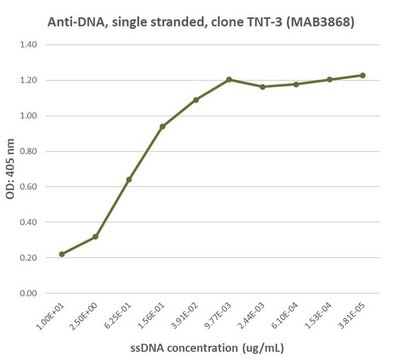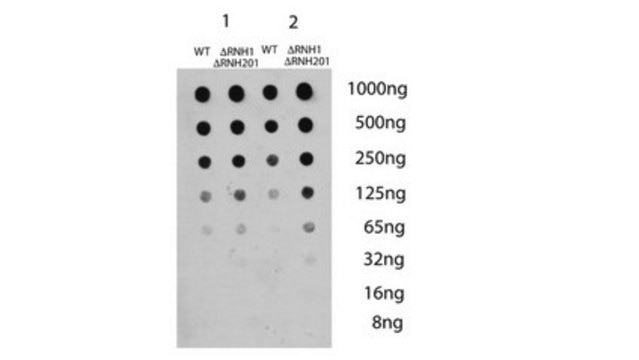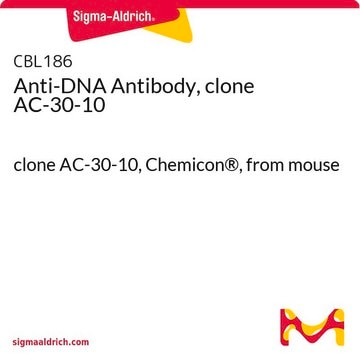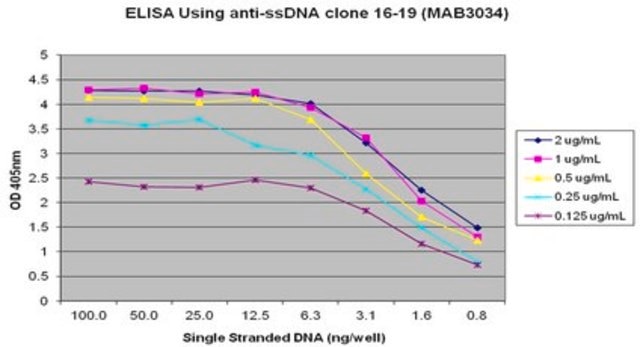MABE1134
Anti-dsRNA Antibody, clone rJ2
culture supernatant, clone rJ2, from mouse
Synonym(s):
Double-stranded RNA
Sign Into View Organizational & Contract Pricing
All Photos(1)
About This Item
UNSPSC Code:
12352203
eCl@ss:
32160702
NACRES:
NA.41
Recommended Products
biological source
mouse
antibody form
culture supernatant
antibody product type
primary antibodies
clone
rJ2, monoclonal
species reactivity
virus
packaging
antibody small pack of 25 μL
technique(s)
immunocytochemistry: suitable
immunofluorescence: suitable
isotype
IgG2aκ
target post-translational modification
unmodified
Related Categories
General description
Double-stranded RNA (dsRNA) is a viral product that induces innate immunity, leading to the production of interferon (IFN) alpha and beta, which can lead to the activation of hundreds of IFN-stimulated genes that confer resistance to viruses. dsRNA of more than 30-bp length are reported to be is a key activator of the innate immune response against viral infections. dsRNA is produced by positive-strand RNA viruses, dsRNA viruses, and DNA viruses. However, negative-strand RNA viruses are not shown to generate any significant dsRNA signals. The interaction of the host cell with dsRNA can occur in several ways. Mainly, specific receptors activate the synthesis of IFN alpha and beta, antiviral proteins, and dsRNA-activated enzymes that can block viral replication. dsRNA replication is shown to occur in the cytoplasm for all dsRNA viruses. This dsRNA-specific mouse monoclonal antibody specifically recognizes dsRNA of more than 40-bp length. Clone rJ2 has been used to detect dsRNA intermediates of multiple types of viruses, including Hepatitis C virus, Dengue virus, rhinovirus, Chikungunya virus, Rabies virus, and Polio virus in biological samples. It can be useful in understanding how anti-viral responses are initiated and what how viruses overcome and avoid these antiviral therapies.
Specificity
Clone rJ2 specifically recognizes double stranded RNA (dsRNA) of greater than 40 bp in length that is generated during the replication of positive sense genome viruses.
Immunogen
Double stranded RNA produced by positive sense genome viruses.
Application
Anti-dsRNA, clone rJ2, Cat. No. MABE1134, is a mouse monoclonal antibody that detects double stranded RNA (dsRNA) and has been tested for use in Immunocytochemistry and Immunofluorescence.
Immunofluorescence Analysis: A representative lot detected dsRNA in Immunofluorescent applications (Savidis, G., et. al. (2016). Cell Rep. 15(11):2323-30; Savidis, G., et. al. (2016). Cell Rep. 16(1):232-246).
Research Category
Inflammation & Immunology
Inflammation & Immunology
Quality
Evaluated by Immunocytochemistry in Dengue virus infected A549 cells.
Immunocytochemistry Analysis: A 1:60 dilution of this antibody detected dsRNA in Dengue virus infected A549 cells.
Immunocytochemistry Analysis: A 1:60 dilution of this antibody detected dsRNA in Dengue virus infected A549 cells.
Physical form
Mouse monoclonal antibody in supernatant without preservatives.
Unpurified
Storage and Stability
Stable for 1 year at -20°C from date of receipt. Handling Recommendations: Upon receipt and prior to removing the cap, centrifuge the vial and gently mix the solution. Aliquot into microcentrifuge tubes and store at -20°C. Avoid repeated freeze/thaw cycles, which may damage IgG and affect product performance.
Other Notes
Concentration: Please refer to lot specific datasheet.
Disclaimer
Unless otherwise stated in our catalog or other company documentation accompanying the product(s), our products are intended for research use only and are not to be used for any other purpose, which includes but is not limited to, unauthorized commercial uses, in vitro diagnostic uses, ex vivo or in vivo therapeutic uses or any type of consumption or application to humans or animals.
Not finding the right product?
Try our Product Selector Tool.
wgk_germany
WGK 3
Certificates of Analysis (COA)
Search for Certificates of Analysis (COA) by entering the products Lot/Batch Number. Lot and Batch Numbers can be found on a product’s label following the words ‘Lot’ or ‘Batch’.
Already Own This Product?
Find documentation for the products that you have recently purchased in the Document Library.
Kim M Stegmann et al.
iScience, 25(5), 104293-104293 (2022-05-03)
The nucleoside analog N4-hydroxycytidine (NHC) is the active metabolite of the prodrug molnupiravir, which has been approved for the treatment of COVID-19. SARS-CoV-2 incorporates NHC into its RNA, resulting in defective virus genomes. Likewise, inhibitors of dihydroorotate dehydrogenase (DHODH) reduce
Jules B Weinstein et al.
iScience, 25(3), 103960-103960 (2022-03-01)
The spike glycoprotein of SARS-CoV-2 engages with human ACE 2 to facilitate infection. Here, we describe an alpaca-derived heavy chain antibody fragment (VHH), saRBD-1, that disrupts this interaction by competitively binding to the spike protein receptor-binding domain. We further generated
Scotland E Farley et al.
Nature communications, 13(1), 3487-3487 (2022-06-18)
A comprehensive understanding of host dependency factors for SARS-CoV-2 remains elusive. Here, we map alterations in host lipids following SARS-CoV-2 infection using nontargeted lipidomics. We find that SARS-CoV-2 rewires host lipid metabolism, significantly altering hundreds of lipid species to effectively
Esen Sefik et al.
Nature, 606(7914), 585-593 (2022-04-29)
Severe COVID-19 is characterized by persistent lung inflammation, inflammatory cytokine production, viral RNA and a sustained interferon (IFN) response, all of which are recapitulated and required for pathology in the SARS-CoV-2-infected MISTRG6-hACE2 humanized mouse model of COVID-19, which has a human
Tomer M Yaron et al.
bioRxiv : the preprint server for biology (2020-08-21)
While vaccines are vital for preventing COVID-19 infections, it is critical to develop new therapies to treat patients who become infected. Pharmacological targeting of a host factor required for viral replication can suppress viral spread with a low probability of
Our team of scientists has experience in all areas of research including Life Science, Material Science, Chemical Synthesis, Chromatography, Analytical and many others.
Contact Technical Service